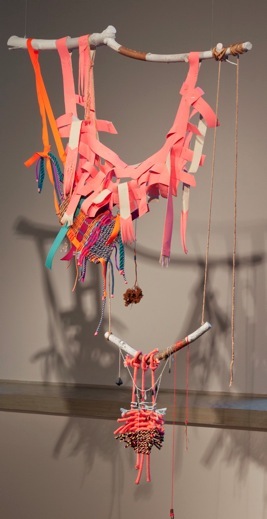SANTOS





personal mythologies





by Zoë Chan
Personal myth is situated in the gap rendered inevitable through the loss of myth.1
Delving into questions surrounding migration and memory, Personal Mythologies presents works by two Montreal-based artists, Osvaldo Ramirez Castillo and Marigold Santos. Characterized by a hybridized visual aesthetic, their art practices collectively reference everything from religious iconographies, storybook illustrations, children’s games, textiles, and medieval bestiaries to political propaganda posters, medical drawings, tattoos, and horror films. Melding elements of these disparate sources, the artists create colourful and complex imagined worlds, each with their own specific visual vocabulary and internal logic.
At the very heart of Ramirez Castillo’s and Santos’ art practices lies a marked fascination with drawing as a potent mode of narrative expression—that is to say, how the very concrete yet fluid act of drawing can make the intangible tangible by bringing to the surface intricate processes of thought, feeling, imagination, and memory. In this light, drawing is ideal for constructing worlds, recounting events, telling tales. However, while the artworks of Ramirez Castillo and Santos are deeply rooted in narrative traditions, their narratives are far from traditional. In structure, they are multifaceted, interlocking, and non-linear while their content is often surreal, ambiguous, and open-ended. Alluding to a multitude of diverse elements sourced from visual and vernacular culture, official and oral histories, age-old folktales and cosmologies, these highly seductive artworks compel the focused attention of viewers in order to decipher the subject matter.
If Personal Mythologies clearly attests to the cross-cultural, cosmopolitan interests and vivid imaginations of Ramirez Castillo and Santos, at the same time, the artworks are equally informed by biographical details and anecdotes culled from the artists’ lives, often revolving around their respective diasporic experiences. The inherently layered, materially mutable medium of drawing tracks their explorations of stories linked to the realm of the personal and the collective, the past and the present, the imagined and the real, the conscious and the unconscious. Concurrently an extension of and a vehicle for storytelling, drawing thus becomes a way for Ramirez Castillo and Santos to revisit, revise, and respond to those disparate, fragmented images, memories, and events that inform and inspire their personal histories.
The cultural scholar Sophia Heller argues in her book, The Absence of Myth, that “Myth may no longer guide and unify the collective, but its absence affords the opportunity to discover my story, my myth, to satisfy the need for a meaningful life….” Within this framework, these densely detailed worlds are not only the fruits of Ramirez Castillo and Santos’ fertile imaginations, but perhaps equally symptomatic of a desire to make sense of their lives as migrant or post-national subjects within the globalized arena, where they are cut off from those apparently seamless “grand narratives”—be they spiritual, cultural, national, and so on—that were supposed to bind the collective. By this token, the artists, through their hybrid mythologies, may be moved to try to make sense of or at least to create a semblance of coherence or beauty from what may be confusing or chaotic contexts. Finally, even as Osvaldo Ramirez Castillo and Marigold Santos take evident pleasure in the visual rendering of their personal mythologies, they critically reveal, through the complex, inevitably heterogeneous nature of these constructions, the inadequacy, if not the impossibility, of the universal narrative.
1 Sophia Heller, The Absence of Myth (New York: State University of New York Press, 2006), 65.
2 Ibid.
